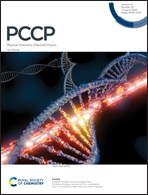Theoretical studies on the photochemistry of 2-nitrofluorene in the gas phase and acetonitrile solution†
Abstract
The photophysical and photochemical mechanisms of 2-nitrofluorene (2-NF) in the gas phase and acetonitrile solution have been studied theoretically. Upon ∼330 nm irradiation to the first bright state (1ππ*), the 2-NF system can decay to triplet excited states via rapid intersystem crossing (ISC) processes through different surface crossing points or to the ground state via an ultrafast internal conversion (IC) process through the S1/S0 conical intersection. The 1nπ* dark state will serve as a bridge when the system leaves the Franck–Condon (FC) region and approaches to the S1 minimum. The molecule maintains a planar geometry during the excited-state relaxation processes. The differences on excitation properties such as electronic configurations and spin–orbit coupling (SOC) interactions between those in the gas phase and acetonitrile solution cannot be neglected, indicating possible changes on the efficiency of the related ISC processes for the 2-NF system in solution. Once arrived at the T1 state, it would further decay to the S0 state or photodegrade into the Ar–O˙ and NO˙ free radicals. During the intramolecular rearrangement process, the twisting of the nitro group out of the aromatic-ring plane is regarded as a critical structural variation for the photodegradation of the 2-NF system. The free radicals finally form through oxaziridine-type intermediate and transition state structures. The present work provides important mechanistic insights to the photochemistry of nitro-substituted polyaromatic compounds.



 Please wait while we load your content...
Please wait while we load your content...